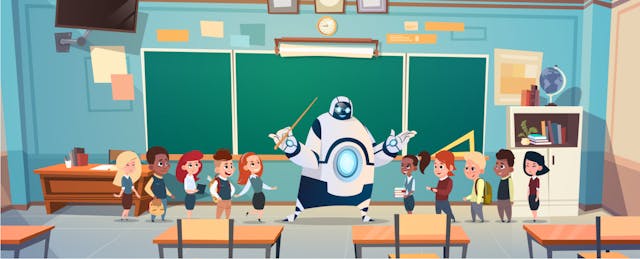Success in our modern economy demands a wide set of skills, including content knowledge, digital literacy, leadership and strong problem-solving abilities. All students need to develop these skills. Early access to varied learning opportunities prepares them to take on challenges and opportunities throughout their lives and reach their full potential.
High quality STEM learning and engagement opportunities can be life changing for young people in disenfranchised communities who otherwise might not have a direct pathway to the fast-growing STEM economy. Studies show that early exposure to science, technology, engineering and math provides students with the foundation necessary to partake in an increased number of STEM careers. However, many schools struggle to offer hands-on learning opportunities, such as robotics programs, because they lack funding, coaches and other forms of support.
A study by Harvard University suggests “that low-income children start out on relatively even footing with their higher-income peers in terms of innovation ability, but fall behind over time, perhaps because of differences in their childhood environment.” By working with teachers, administrators, families, students and communities to remove barriers, we can provide all students the opportunity to participate, learn, grow and thrive.

FIRST, an inclusive robotics community working to prepare young people for the future, understands the broad societal context of economic, educational and social factors historically leading to disproportionate access and outcomes. A vital part of our strategic intent is to serve an inclusive and diverse audience, reflecting the population of the communities we serve.
Bring engaging robotics programs to your school.
Students engaged in STEM programs are prepared for success in the classroom and the workforce. According to a five year study by Brandeis University of FIRST participants, these students were three times more likely than their peers to show gains in STEM career interest. This impact is evident regardless of race, gender, income or community type.

Discover how you can increase STEM engagement for your students. The following strategies can be employed at any school to create opportunities for all, especially underserved, underrepresented and vulnerable students who may otherwise lack access.
1. Train educators to think like coaches.
In-person and virtual learning experiences give teachers confidence to coach STEM and robotics programs. Look for STEM programs and online resources that provide step-by-step curriculum designed for the classroom or PD opportunities for teachers. The Next Generation Science Standards site offers case studies with classroom strategies teachers can practice and apply to make STEM accessible to all students.
The National Alliance for Partnership in Equity and robotics community FIRST have teamed up to offer complimentary interactive online courses for educators and STEM program coaches that include specific strategies to support community outreach, student participation, persistence, engagement and success.
Three teachers in Brooklyn, NY who felt inexperienced with robotics started a program for their classroom. Working together, the teachers were able to help build soft skills, provide hands-on problem-solving and create new learning opportunities for a class largely comprised of kids with special needs.

2. Build relationships in the local community.
When educators draw on community support to start or expand STEM programs, they thrive. By inviting local experts for presentations or mentorships, schools can bring in additional resources, leadership and expertise to build their programs.
While school-age children spend only about 20 percent of their waking hours in school, many consider community-based organizations a home away from home. These organizations are increasingly incorporating STEM activities and learning into their program offerings. FIRST collaborates with youth-focused organizations like 4H, Boys and Girls Clubs, Girl Scouts, YMCA, Girls Incorporated and City Year to ensure quality STEM enrichment beyond the school day.
3. Encourage peer-to-peer and near-peer mentoring.
Creating opportunities for young people to teach one other builds skills, confidence and relationships among both mentors and mentees. Engaging robotics programs give students the chance to develop leadership skills. Two teen sisters in Ellensburg, Washington were inspired by their own hands-on coding and building experiences and are now working to help as many girls as possible feel the same thrill. “Our ultimate mission is to target teams in rural areas to make trying to start robotics teams a little bit easier,” says Parker, one of the sisters.
Reach out to members of local robotics teams and invite them to mentor your students. Many teams do community outreach to teach others coding and problem-solving skills and have even started Facebook pages to connect students and teachers. FIRST also hosts a search engine for finding local area teams.
Consider having teachers and students complete complementary youth trainings focused on equity, diversity and inclusion. This can help your students feel empowered and confident as they develop their STEM skills and engage with other students and mentors.
4. Remove barriers for students who lack resources.
Students can’t focus when they’re hungry; nor can they participate in after-school events if access to transportation is limited. Funding for snacks, after-school travel and other related expenses can level the playing field and allow disadvantaged youth to participate meaningfully. You can address these very basic needs by strategically providing transportation, food, childcare and/or teacher-coach stipends.
Need help finding funds? Read on.
5. Find additional funding for STEM.
A school never functions in isolation. When reaching out to local organizations, consider asking businesses to support a program or team in your school through in-kind or financial donations. They may even supply snacks, tools, a space to meet after-school or sponsorship opportunities.
Grants for innovation and school projects are readily available as well. All you need to get started is your school’s Tax ID and a brief summary of your funding needs, materials and goals. Resources for local and national programs, and for classrooms and school districts, can be found at DonorsChoose.org, STEMGrants.com and NEAFoundation.org, among others. Your school may also consider applying for future FIRST STEM Equity Community Innovation Grant opportunities.

Through hands-on STEM and robotics programs, students from all walks of life can develop self-confidence in STEM and valuable, real-world skills—such as digital literacy, teamwork, leadership, creative problem solving and project management—that open pathways to all career choices and outcomes. When teachers, schools and communities work together to provide these programs and implement inclusive strategies, every student can be successful.



